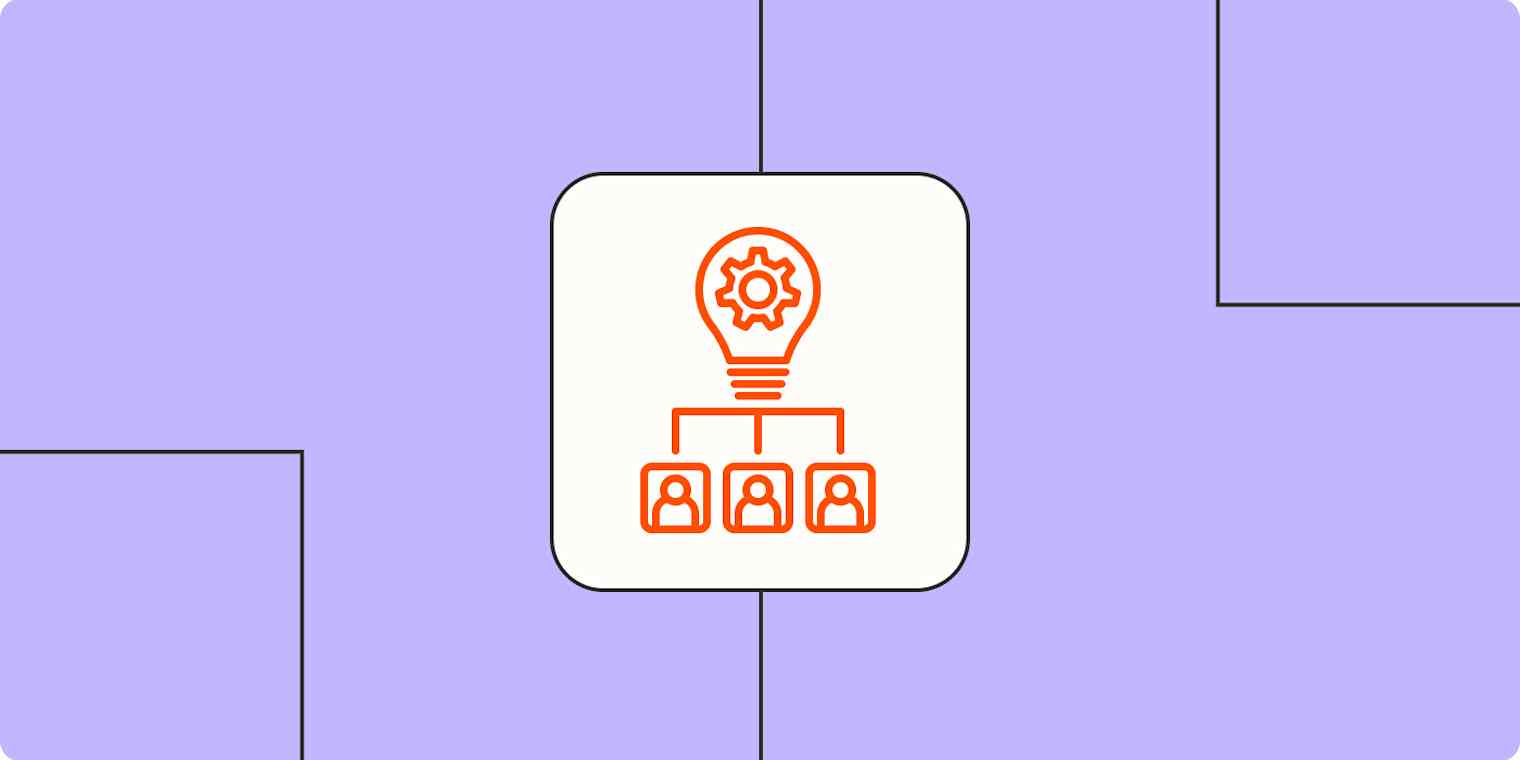If you're anything like me, coming up with ideas on the spot is really hard—unless it's 3 a.m. on a Tuesday and you're desperately trying to fall back to sleep.
But if you work in any sort of creative job or a role that requires problem-solving, coming up with ideas is probably a large part of what you're paid to do. And that can really put the pressure on: not only do you have to have ideas frequently, but you need to have them in a group setting. If you're introverted like I am, that makes it even harder to feel confident in what your brain is doing.
Enter brainwriting: A collaborative, iterative method for generating ideas.
Table of contents:
What is brainwriting?
Also known as 6-3-5 brainwriting or the 6-3-5 method, brainwriting is a practice designed to stimulate creativity and help groups generate ideas. Originally developed in the late 1960s by Bernd Rohrbach, a German marketer, it guides a small group of people through several rounds of communal ideation and refinement.
Six people identify a problem statement, i.e., what they're trying to solve. Each participant then writes this statement at the top of a rubric (known as the Idea Form). Then, they try to generate three ideas in five minutes. Six people, three ideas each, in five minutes—or 6-3-5.
Unlike traditional verbal brainstorming, the ideas are written out or expressed through symbols and drawings. And once the five minutes ends, each participant passes their sheets to the person to their right, and the process repeats. Rinse and repeat until the entire Idea Form is full.
At the end of the process, the group screens the ideas generated, removes duplicative ideas, and selects a few ideas to develop further.
Brainwriting vs. brainstorming
Brainwriting and brainstorming both offer teams a way to achieve the same thing: new ideas. But how they go about it is different. Here are the key differences between brainstorming and brainwriting.
| Brainwriting | Brainstorming |
|---|---|---|
Process
| Participants write down ideas individually before sharing, usually in a structured, timed approach. | Participants verbally share ideas in real-time, often in a free-flowing manner. |
Communication style | Independent and written; focuses on individual idea generation without immediate feedback. | Open and interactive; encourages immediate discussion and feedback. |
Who it's for | Ideal for introverts, larger groups, or settings where equal participation is prioritized. | Suitable for extroverted groups and those comfortable with open discussion. |
Benefits of brainwriting
Apart from enabling teams to engage in a truly collaborative ideation process, brainwriting offers a few other key benefits.
It's graphic. Participants write down their ideas or draw them, which may unlock creativity by engaging different parts of the brain.
It's iterative. Participants can improve or expand upon others' ideas, instead of just coming up with new ones. Theoretically, seeing ideas written down from round to round should help spark ideas that wouldn't have otherwise come up. It should also help the group refine ideas, so they can move forward with the best possible options after the session.
It encourages equal participation. By using a rubric to guide the process, brainwriting prevents one or two people from monopolizing the discussion.
It's good for introverts. Because it's not verbal, it gives less confident or more introverted folks a chance to contribute ideas.
It reduces groupthink. Every participant generates ideas independently before sharing them with the group, which reduces the influence of dominant voices and encourages diverse perspectives.
It's time-bound. If you have six people, this activity takes 30 minutes flat. Since it's timed, there isn't as much of a risk of it ballooning into a time suck.
Brainwriting template: How to use the brainwriting method

When you're ready to run your first brainwriting session, just follow these steps:
Make sure you have the right rubric handy. I created one for you, which you can copy and edit to match the number of participants. If you use a whiteboard app or other brainstorming tool, like Miro or FigJam, you may be able to find a pre-made brainwriting template there.
Assign a moderator. They'll help keep the group on track from round to round, along with guiding the quick screening at the end of the activity.
Do the first round. Start the timer, and give everyone five minutes to put three ideas in the Idea From.
Pass your Idea Form to the right. Rinse and repeat for five more rounds.
Discuss the ideas on your rubrics together. Have your moderator lead a discussion aimed at creating a shortlist of the most promising or popular ideas. Then outline next steps.
When to use brainwriting
Here are a few scenarios where brainwriting can be an effective way of drawing out ideas.
When you've hit an idea block. If you're really stuck—like total, my-brain-is-broken, all-my-ideas-are-bad stuck, brainwriting can take some of the pressure off because it's not about having good ideas right out of the gate. It's about getting the kernels of an idea onto paper in a group situation, where no one is immediately singled out or asked to defend their thinking.
When you want to foster collaboration with your coworkers. Because brainwriting isn't competitive—no one is trying to convince others that their idea is the right one—and iterative (meaning you can read and develop other folks' ideas), it forces the group to work as a team. If you're a newer group or a group that's struggled to connect creatively, brainwriting can be a powerful tool to strengthen your relationships with one another.
When you want to surface common idea threads. Very rarely does one person have the singular answer to a problem or question; teams tend to think alike. Brainwriting, then, is great for bringing those common ideas or threads to the surface in a collaborative and iterative way.
When you're in a large group setting. Since brainwriting offers a structured and time-bound system for generating ideas, it's more efficient than traditional brainstorming, where everyone throws out ideas at random.
When to avoid brainwriting
Of course, brainwriting isn't for everyone or every situation. Here are some instances when you should avoid using brainwriting.
When immediate feedback is needed. If real-time discussion and feedback are essential for refining ideas, brainwriting may slow down the process.
In time-sensitive situations. For quick, on-the-spot ideation with a smaller team, it may be faster to use traditional brainstorming than the structured approach of brainwriting.
With a small, highly aligned team. If you're working with a small team and everyone is comfortable sharing openly, brainstorming might be more efficient and collaborative.
When visual or physical interaction is necessary. Brainwriting doesn't lend well to ideation processes that require physical props, sketches, or hands-on collaboration.
6-3-5 brainwriting: another tool in your creativity toolbox
Brainwriting is a versatile tool for your brainstorming toolbox. Whether you're mind-numbingly stuck or looking to bring your team closer together, it's worth trying—the worst-case scenario is that you wind up with dozens of just ok ideas, which is still more than zero.
And if you want to improve your brainstorming and collaboration even more, consider automating parts of the process with Zapier. By connecting popular apps like Asana and Slack, you can make sure you actually follow up on all the new ideas you came up with in your brainwriting session. Learn more about how to automate your brainstorming workflows.
Related reading:
This article was originally published in January 2024. The most recent update, with contributions from Jessica Lau, was in November 2024.









